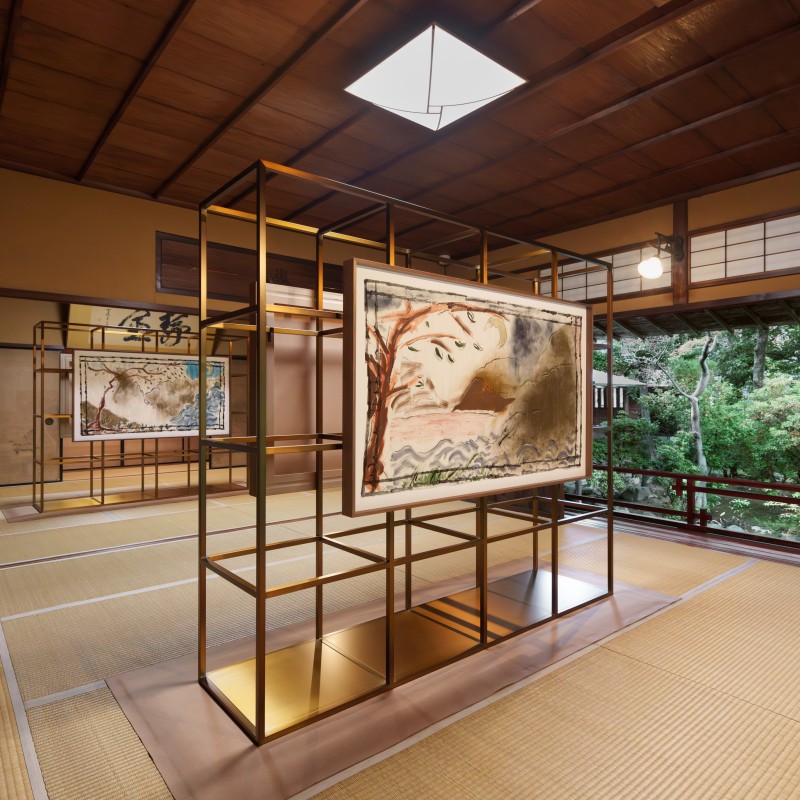At the Kōseiin Temple in Kyoto, Italian artist and writer Isabella Ducrot presents her ongoing Bella Terra and Incongruous series, marking her first exhibition in Japan since 1990. In dialogue with the temple’s unique environment, these two distinct bodies of work on rare papers are informed by Ducrot’s continued celebration of pattern and repetition from a material and philosophical perspective. The artist has dedicated her career to amplifying textiles in all forms, from the simple to the intricate, treating each design as a lyrical motif or rhythmic prayer with meditative potential, accentuated in this exhibition by the serenity of the sacred setting.
Ducrot’s Bella Terra series, presented here from a five-year period of making, represents the boundless wonder in simplicity. Translating to ‘Beautiful Land’, the duplicated perspectives on paper provide shifting impressions of an idyllic, untouched landscape. Each is faithfully bound to the triad of primordial elements that define the series: a leaning tree shaped by wind, a hilled vista meeting flowing water and the light of a crescent moon. Ducrot’s devotion to documenting the evolving scene – as if compelled to continuously witness the changing seasons or capture the passing of time – embodies her belief in repetition as a fundamental vehicle for artistic interpretation and a symbol of life’s rhythm. Presented in this exhibition in pairs, the peaceful scenes call to mind natural dualities: day and night, land and sky, heaven and earth. Seemingly straying further from their formal subject matter as the series unfolds, Ducrot’s Bella Terras are no longer defined by the unknown landscape she returns to, rather the intrinsic beauty of these elements contemplated in art since the beginning of time. Their scale, composition and materiality become subjects in their own right.
While her Bella Terras are characterised by synchronicity – a quiet harmony or natural order – Ducrot’s Incongruous series is shaped by contrast and subtle conflict between forms. A collection of uniform works occupy the upper floor, each refined to chosen signifiers of domestic space: a flower-filled vase, a steaming teapot or a patterned tabletop. In her latest published writing, Recent Animals, Ducrot reflects on her enduring respect for paper and textile, their role as her main source of inspiration and her commitment to pattern beyond its decorative potential.[1] Having uncovered her initial fascination with simple material in her writings, Ducrot expands on the significance of the chequered cloth in such works: ‘I attempt to translate and transport the conventional meaning of the cloth/object beyond its destiny of domestic utility, of protecting the body, enabling it to retrieve its original meaning as adjacent as possible to the concept of Beauty.’[2] By placing recurrent elements emblematic of calm interiors within such open, unrestrained compositions, Ducrot controls and broadens the appreciation of their aesthetic forms. Orchestrating an incongruous tension between ‘fullness’ and ‘emptiness’ in every piece, Ducrot considers the threads of her fabric as ‘the crossbeams of the composition, allowing their intersections to simultaneously create welcoming spaces.’[3] These intentional voids play a crucial role in emphasising the pure beauty of material – of the pigments, China ink, textiles and collage all carefully combined on Japanese paper by Ducrot – and the surrounding open space holds equal substance. Ducrot’s works illustrate her unwavering belief that every piece of cloth contains a non-corporeal spirit that exceeds a visual and tactile sensory experience, trusting that ‘the structure of any old brocade rag inherently offers a space to accommodate what, though insubstantial, simply must be present: with each beat of the loom, the weaver captures and imprisons something, almost a breath that settles in the confined space between fibers, bringing the creation to life. […] If one is only able to listen, every piece of cloth has its own epic story to tell.’[4]
At the core of Ducrot’s practice is contemplation. The artist’s philosophy of identifying beauty in the simple and refined recurrences in life extends from her writing into her material creations, and the Incongruous exhibition brings this sentiment into the experiential.
[1] Isabella Ducrot, Recent Animals (Rome: Quodlibet, 2025), p. 48
[2] Ibid.
[3] Ibid., p. 51
[4] Ibid., p. 48
Isabella Ducrot (b. 1931, Naples, Italy) has exhibited internationally since the mid-1980s, including at the Venice Biennales of 1993 and 2011. Recent solo exhibitions include Profusions, Sadie Coles HQ, Kingly Street Viewing Room, London (2025); WEAVING IS HUMAN. Isabella Ducrot... and the textile collections of the Museum of Civilizations, Museo della Civiltá, Rome (2024); Remembering flowers, Sadie Coles HQ, London (2024); Profusione, Le Consortium, Dijon (2024); La Bella Terra, MAXXI, Palazzo Ciampoli, Taormina(2023); other things, Sadie Coles HQ, London (2023); and La Bella Terra, Villa San Michele, Capri (2023). Her work has been included in numerous recent group shows including Lithos / Lethe (Stone vs Oblivion), Hydra School Projects (2025); Arte Povera – A New Chapter, EMMA Espoo Museum of Modern Art (2025); Women artists. Paths in graphics from the twentieth century to today, Central Institute for Graphics, Rome (2023); and Super Super Markt, Berlin (2023). She is the author of numerous philosophical and art-historical essays, including the books Twenty-Two Places of the Soul (2022), Women’s Life (2021) and The Checkered Cloth (2019) all published by Quodlibet. In January 2023, the publishing house released a new catalogue, entitled Isabella Ducrot: Stoffe (Isabella Ducrot: Fabrics), an in-depth anthology of the artist’s exquisite collection of rare fabrics amassed over the course of her lifetime; presenting two hundred and fifty-two fabrics that originate from across four continents. Ducrot’s work is held in numerous public collections including Astrup Fearnley Museum, Oslo; Galleria Nazionale d’Arte; Moderna e Contemporanea, Rome; MAXXI – Museo nazionale delle arti del XXI secolo, Rome; MAMCO, Geneva; and Le Consortium, Dijon. Ducrot lives and works in Rome.
